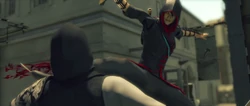The Chinese Assassins were the Brotherhood of Assassins in China, one of the few Brotherhoods to have existed for more than a thousand years.
Primarily focusing on dealing with several Templar-backed Chinese Emperors, the Chinese Assassins have often been in difficult positions, as the Chinese Templars held the majority of power in China on numerous occasions.
In 1524, the Chinese Assassins were almost completely rooted out through a ruthless purge by the Emperor Jiajing, with the remaining Assassins fleeing China altogether, seeking support from other branches in the Assassin Order.
History
Assassination of Qin Shi Huang
During the 3rd century BCE, Emperor Qin Shi Huang, supported by the Templars,[1] unified China under his banner and became the first Emperor, starting the Qin Dynasty.
However, in 210 BCE, the Assassin Wei Yu killed the tyrant Emperor with a spear, making Wei Yu one of the most renowned members of the Order.[2]
Yongle's purge

Li Tong and an apprentice escaping the purge
By the 15th century, the Chinese Assassins were led by the teacher Fang Xiaoru. In 1402, the Imperial throne was usurped by Yongle, supported by the Templars. Under Yongle's rule, thousands of Assassins were rounded up and executed, including Fang Xiaoru. However, a young female Assassin named Li Tong and an Assassin apprentice were able to escape the purge with an Apple of Eden. This caused Li to devote herself to protecting the Apple and keeping it out of Yongle's hands.[3]
In 1424, while Yongle attempted to suppress a rebellion near the Gobi Desert, Li Tong slipped into Yongle's tent and killed the Emperor.[3]
Fall of the Brotherhood
In 1521, after the death of Emperor Zhengde, and while the administration was preoccupied with looking for an heir, the Assassins infiltrated the Imperial Palace to rescue the Emperor's concubines. In the process, they recruited a young woman named Shao Jun into the Brotherhood, though many concubines had to be left behind.[1]
In 1524, the new Emperor, Emperor Jiajing, again aided by the Templars, nearly destroyed the Assassin Order in China, determined to eliminate all groups who opposed him.[1]

Shao Jun and Ezio Auditore, before her departure
The remaining Assassins traveled West in groups, with Shao Jun and her Mentor heading for Italy. In Venice, they were intercepted by Jiajing's men, and her Mentor was killed. Eventually continuing on to Florence, Shao Jun met Ezio Auditore da Firenze, the retired leader of the Italian Assassins and a former Mentor in the Assassin Order. Despite her desire to learn from him, Ezio, then 65 years old, was unwilling to help Jun at first.[4]
After discovering the fate of the Chinese Assassins, Ezio decided to support her, eventually fighting off more of Jiajing's assailants in Ezio's home. With Ezio's knowledge and a secret box to only be used in times of dire need, Shao Jun started to make her way back to China, determined to rebuild the Order's presence there.[4]
Techniques
The techniques of the Chinese Assassins differed greatly from those of the other Assassin branches. Most notably, the Chinese Assassins did not use Hidden Blades;[4] the signature weapon of the Assassins in Europe, the Middle East and Colonial America.[2]
Instead, the Chinese Assassins wore bracers equipped with needles, in place of Hidden Blades. Being located close to the hands, the Assassins could quickly throw multiple needles in a row.[4]

Shao Jun using her concealed blade
Additionally, the Chinese Assassins wore concealed blades in their footwear, which came to good use with their Chinese fighting techniques, that involved the use of the leg and foot more often.[4]
The Chinese Assassins would eventually use the rope dart weapon created by Shao Jun after her travels to Europe, for which she became renowned.[5]
Appearance
The Assassins' robes did not always meet normal Assassin customs. On many occasions, Assassins wore ordinary Chinese clothing, making them hardly recognizable as Assassins.[2][3]
It was only during the height of the Renaissance period in Europe that the Chinese Assassins ordinarily wore hoods; despite this, the Assassins did not necessarily wear white, as Shao Jun wore black Assassin robes.[4]
